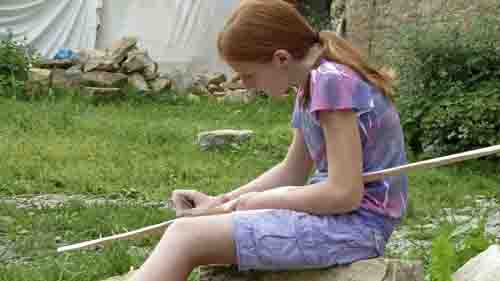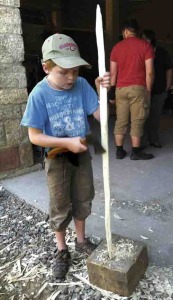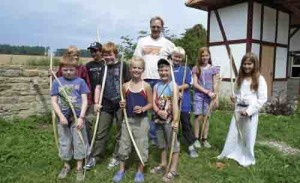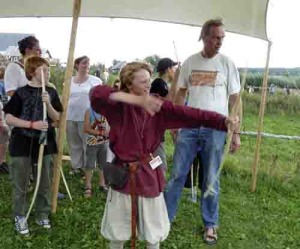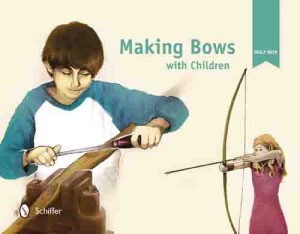Got a budding bowyer in the family? A new book from German historian and craftsman Wulf Hein shows you how to build a starter bow. Angelika Hornig asks the questions
Wulf Hein is a craftsman specialising in the reconstruction of historical finds, and he has been an expert in experimental archaeology and achaeotechnology for more than 20 years. Whether bow and arrow, wooden log boat, Ötzi’s fur clothes or a Neolithic village, he has rebuilt and reconstructed a lot of things that today are displayed in museums and exhibitions, or that can even be seen in film. He is also active as an author, and has written books for school lessons and for archery magazines. Here, Angelika Hornig asks him about his latest book Making Bows with Children, which aims to get young archers involved in making their own kit.
AH: Wulf, how did you get the idea for the book Making bows with children? Did your own children inspire you?
WH: The idea for the book came after my teaching materials about the stone age, Romans, and middle ages became really popular. I have two children of my own – but though they are too old to fit in the target group, in the past they loved practising archery with me, and of course they both have a self-made wooden bow.
AH: How long did it take you to get from the first idea to the finished manuscript?
WH: In summer 2006 I thought of a book like that for the first time, in 2007 we talked about how to realise it, and as your persistent demanding for the book was finally successful, the German issue was released in 2011. Now, it’s also available in English.
AH: What target age group is the book for?
WH: The book was made for children and young people, though it can be for anyone from eight to 99! It offers the opportunity to build either a very simple bow or a more challenging flatbow of the stone age Holmegaard type. It is suitable for making a bow on your own as well as together.
AH: Most manuals of this type start with an already dried piece of wood, but your book started with the trees. What did you intend by writing it this way?
WH: I started the book this way on purpose, as many children (and adults) do not know the different trees and woods that are suitable for bow making. You can make mistakes even by harvesting and drying the wood, so the book provides guidance and advice for this.
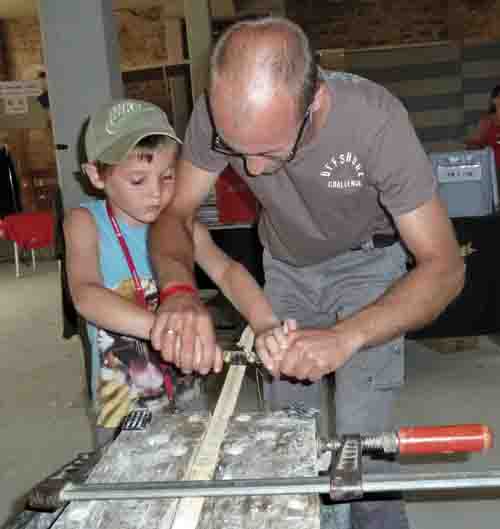
Some of the more difficult bits might require adult help, but most of the project can be done by children
AH: Some of the steps of the procedure you could have left out, or would be easier with special tools. Was it your intention to recommend only a few, simple tools?
WH: Not everyone has got a well-equipped workstation at home, so I have focused on tools and resources that can be acquired easily and cheaply.
AH: Isn’t it too dangerous for a child to work with tools like this?
WH: I tried to explain the tools in detail, and safety advice fills a lot of space in the book. Basically, I think that children today practise too little handcrafting; instead, they prefer hanging around in their rooms with electronic gimmicks. Some children are even incapable of twisting a simple cord, which is what I often experienced at my exhibitions in museums, and only a few play outside the house. Educationists always point out how important playing outside and the experience of things. Where it becomes risky, such as working with electric tools, I recommend working together with an adult.
AH: Why do you think it is important for children to learn how to create something with their own hands?
WH: I know from my own experience that it’s very important for the development of children for them to start something manually on their own, and to bring it to an end. When they finally hold the result of their effort in their hands and have a lot of fun with it, this creates self-esteem and makes them proud of their own work.
AH: You are an archaeological technician, so the historical background is very important to you. Was this the reason you wrote a large chapter about the history of the bow and arrow?
WH: I believe that the book would be incomplete if I had only written a manual for bow making. If you deal with a complex topic like the bow, you should get an overview of the history behind it in order to understand it completely. Furthermore, something like this did not exist for children before, but many people asked for it.
AH: So the book is not only suited for children?
WH: I hope that the book also attracts adults, who will mostly not be experts in archery and bow making. It is surely a way to get into the topic, especially for teachers, therapists, and youth group coaches, who want to know more about it and intend to offer it as part of their programs.
AH: When your book was issued in Germany, You performed a two-day bow making class with 10 children during an archery competition. How did the children deal with the course?
WH: The feedback from the kids was completely positive, even though the time set aside was not quite enough and I often had to help them in the process. If you work at home with your son or daughter, or in a group with children, you do not need to finish everything during a weekend. Eventually, we had to improvise. But everyone went home with a bow, and the happy faces of the children when shooting their bows for the first time, spoke for themselves.
AH: Did you make any important discoveries?
WH: Well-dried hazelwood is indeed very useful for making a simple bow; and here and there some of the procedures I described in the book can be slightly improved.
AH: In the end, is there something you would like the children and readers to know?
WH: Letting arrows fly is one of the best outdoor experiences I can imagine, it demands and supports your head and your hands, so I recommend making yourself a bow and going out to enjoy the fresh air. May all your arrows hit the mark!
THE BOOK:
Making bows with Children
Published by Schiffer Publishing
£27.50
Distributed in the UK by Bushwood Books


